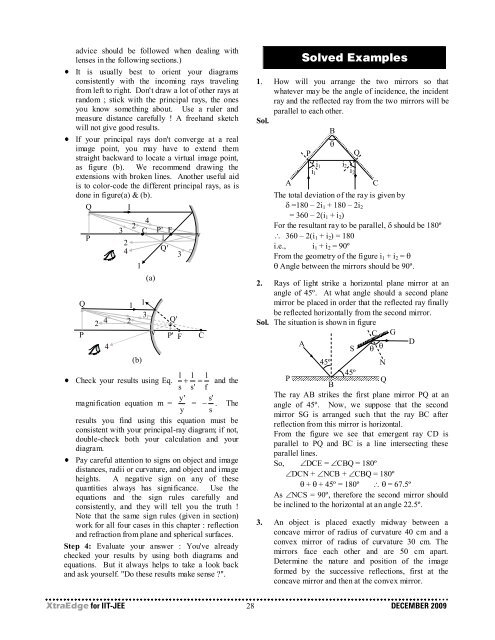Create successful ePaper yourself
Turn your PDF publications into a flip-book with our unique Google optimized e-Paper software.
advice should be followed when dealing with<br />
lenses in the following sections.)<br />
It is usually best to orient your diagrams<br />
consistently with the incoming rays traveling<br />
from left to right. Don't draw a lot of other rays at<br />
random ; stick with the principal rays, the ones<br />
you know something about. Use a ruler and<br />
measure distance carefully ! A freehand sketch<br />
will not give good results.<br />
If your principal rays don't converge at a real<br />
image point, you may have to extend them<br />
straight backward to locate a virtual image point,<br />
as figure (b). We recommend drawing the<br />
extensions with broken lines. Another useful aid<br />
is to color-code the different principal rays, as is<br />
done in figure(a) & (b).<br />
Q<br />
P<br />
Q<br />
P<br />
4<br />
3<br />
I<br />
2<br />
4<br />
1<br />
4<br />
2 2<br />
2<br />
1<br />
(b)<br />
4<br />
C<br />
1<br />
3<br />
(a)<br />
v<br />
P'<br />
Q'<br />
F<br />
Q'<br />
3<br />
P' F<br />
1 1 1<br />
Check your results using Eq. + = and the<br />
s s' f<br />
y'<br />
s'<br />
magnification equation m = = − . The<br />
y s<br />
results you find using this equation must be<br />
consistent with your principal-ray diagram; if not,<br />
double-check both your calculation and your<br />
diagram.<br />
Pay careful attention to signs on object and image<br />
distances, radii or curvature, and object and image<br />
heights. A negative sign on any of these<br />
quantities always has significance. Use the<br />
equations and the sign rules carefully and<br />
consistently, and they will tell you the truth !<br />
Note that the same sign rules (given in section)<br />
work for all four cases in this chapter : reflection<br />
and refraction from plane and spherical surfaces.<br />
Step 4: Evaluate your answer : You've already<br />
checked your results by using both diagrams and<br />
equations. But it always helps to take a look back<br />
and ask yourself. "Do these results make sense ?".<br />
v<br />
C<br />
1. How will you arrange the two mirrors so that<br />
whatever may be the angle of incidence, the incident<br />
ray and the reflected ray from the two mirrors will be<br />
parallel to each other.<br />
Sol.<br />
B<br />
A<br />
Solved Examples<br />
θ<br />
P<br />
Q<br />
i 1 i 2<br />
i 1 i 2<br />
The total deviation of the ray is given by<br />
δ =180 – 2i 1 + 180 – 2i 2<br />
= 360 – 2(i 1 + i 2 )<br />
For the resultant ray to be parallel, δ should be 180º<br />
∴ 360 – 2(i 1 + i 2 ) = 180<br />
i.e., i 1 + i 2 = 90º<br />
From the geometry of the figure i 1 + i 2 = θ<br />
θ Angle between the mirrors should be 90º.<br />
2. Rays of light strike a horizontal plane mirror at an<br />
angle of 45º. At what angle should a second plane<br />
mirror be placed in order that the reflected ray finally<br />
be reflected horizontally from the second mirror.<br />
Sol. The situation is shown in figure<br />
C G<br />
A<br />
S θ θ<br />
D<br />
P<br />
45º<br />
45º<br />
B<br />
N<br />
Q<br />
The ray AB strikes the first plane mirror PQ at an<br />
angle of 45º. Now, we suppose that the second<br />
mirror SG is arranged such that the ray BC after<br />
reflection from this mirror is horizontal.<br />
From the figure we see that emergent ray CD is<br />
parallel to PQ and BC is a line intersecting these<br />
parallel lines.<br />
So, ∠DCE = ∠CBQ = 180º<br />
∠DCN + ∠NCB + ∠CBQ = 180º<br />
θ + θ + 45º = 180º ∴ θ = 67.5º<br />
As ∠NCS = 90º, therefore the second mirror should<br />
be inclined to the horizontal at an angle 22.5º.<br />
3. An object is placed exactly midway between a<br />
concave mirror of radius of curvature 40 cm and a<br />
convex mirror of radius of curvature 30 cm. The<br />
mirrors face each other and are 50 cm apart.<br />
Determine the nature and position of the image<br />
formed by the successive reflections, first at the<br />
concave mirror and then at the convex mirror.<br />
C<br />
XtraEdge for <strong>IIT</strong>-<strong>JEE</strong> 28 DECEMBER 2009

















